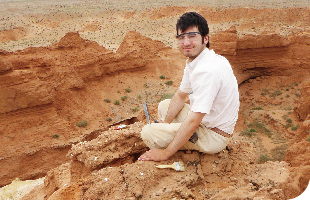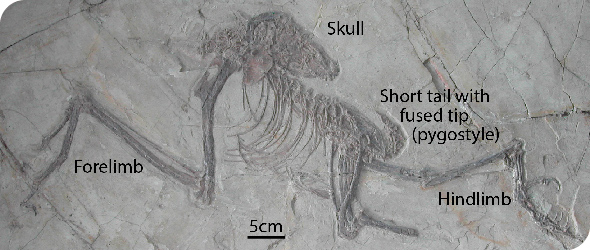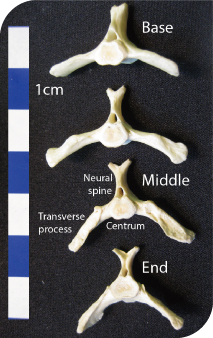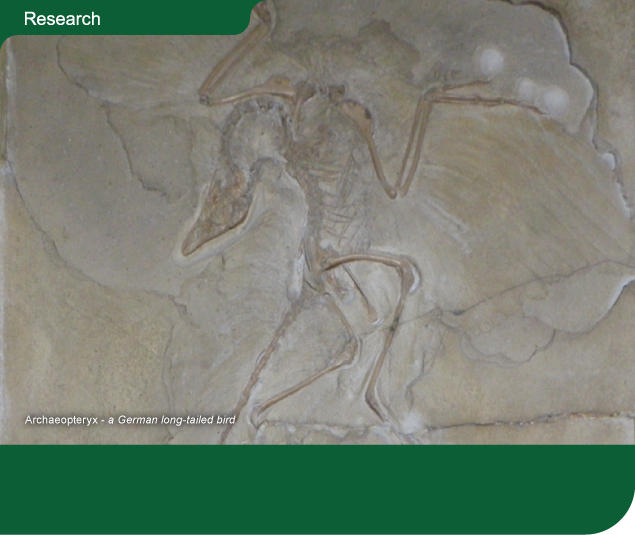This work is an important new step towards broader reconstructions of tail evolution in birds that incorporate all of the forces acting on the tail, including aerodynamic ones.
Dr Michael Pittman Dr Michael Pittman excavating dinosaur fossils in the Gobi desert
Dr Michael Pittman excavating dinosaur fossils in the Gobi desert
Man’s earliest inkling that birds are a type of theropod dinosaur (two-legged, carnivorous dinosaurs including Tyrannosaurus rex) came in the mid-19ᵗʰ century with the discovery of Archaeopteryx – a fossil bird with a long tail resembling those from theropods known at that time.
The evolutionary history of theropods is well studied, and Dr Michael Pittman from the Department of Earth Sciences has added to our understanding of these animals with his recent research on their tails. His study is the first to quantitatively evaluate the biomechanical consequences of the tail’s morphological transformation.
“The research question is a big one about a classic evolutionary change,” says Dr Pittman. “This change is as striking as when fish first left the water to become amphibians. Earlier theropod dinosaurs lived on the ground but one later theropod subgroup, the birds, took to the skies – it was a huge evolutionary transition.”
His research has yielded significant results – revealing how the tail of the theropod dinosaurs evolved from a basic counter-balance enabling them to stand, into the short tails of modern birds used as an aerodynamic surface to produce highly proficient and manoeuvrable flight. The aerodynamic surface is a fan of rectrices (tail feathers) controlled by tail muscles. Living birds with fanning capabilities have short, wider than tall, tail vertebra indicating that their intervening joints are difficult to bend. From this characterisation the research revealed that tail fanning appeared – 30 million years earlier than previously thought – at the ornithuromorphan rather than ornithuran node.
“This work is an important new step towards broader reconstructions of tail evolution in birds that incorporate all of the forces acting on the tail, including aerodynamic ones,” says Dr Pittman. “The research suggests that as birds evolved they became more proficient and manoeuvrable flyers. Other authors have reached similar conclusions but our new, quantitative approach strengthens this hypothesis.”
The research was partly inspired by JH Long’s work on dolphin spines, which included measurements of the force required to bend vertebral joints through a given angle, a property called joint stiffness. “He related joint stiffness to the vertebral geometries associated with each joint,” says Dr Pittman. “He found that certain dimensions of the vertebra were correlated with joint stiffness in the vertical plane, as you moved along the tail.
 Sapeornis – a Chinese short-tailed bird
Sapeornis – a Chinese short-tailed bird
Tail reconstruction
 Turkey tail bones
Turkey tail bones
“This model provided an exciting opportunity to reconstruct tail joint stiffness in dinosaurs since their fossils do not readily preserve soft tissue. Our research is the first that uses a large theropod dataset, and includes horizontal joint stiffness, as dinosaur tails moved mainly horizontally rather than vertically, as in dolphins. The science behind the model relates to lever and beam mechanics, which is Newtonian physics, so this should be applicable to all vertebrates, including dinosaurs.”
Dr Pittman was interested in how tail joint stiffness evolved between earlier theropods and birds – “I took the vertebral geometry data for all of the tails I studied and used these data to reconstruct the same vertebral geometries at the common ancestors of the theropod tree; these hypothetical tail morphologies were used to infer joint stiffness at these nodes. With these reconstructions I studied changes in tail joint stiffness along the line of descent from early theropods to birds and evaluated their biomechanical consequences.’’
He found that the tail of the theropod common ancestor is much taller than wide, which indicates that it is stiffer vertically than horizontally. So before birds evolved, theropods were well adapted to holding their tail up and using it as a static counter-balance.
“As non-avian theropods evolved, joint stiffness decreased in both the vertical and horizontal planes,” he says, “allowing the tail to become more effective at using movements to maintain balance, as a tightrope walker uses the movements of a pole to keep balanced.
“But then with birds, the joint stiffness pattern reverses. We hypothesised that joint stiffness would keep decreasing as the tail shortened, but what we actually found in birds was the opposite. We think that this discrepancy relates to the tail’s aerodynamic function.”
With a stiff tail birds could produce larger forces with their muscles, which in turn allowed them to use larger lift forces during flight with their shorter, more feathered tails.
Hand-in-hand with that, the most recent bird tails became more mobile with the loss of bony vertebral articulations. “This change and the tail’s ability to use larger lift forces allowed birds to produce a wider range of aerodynamic forces,” says Dr Pittman, “and this led to the amazing flight skills seen in birds like swallows.”■


